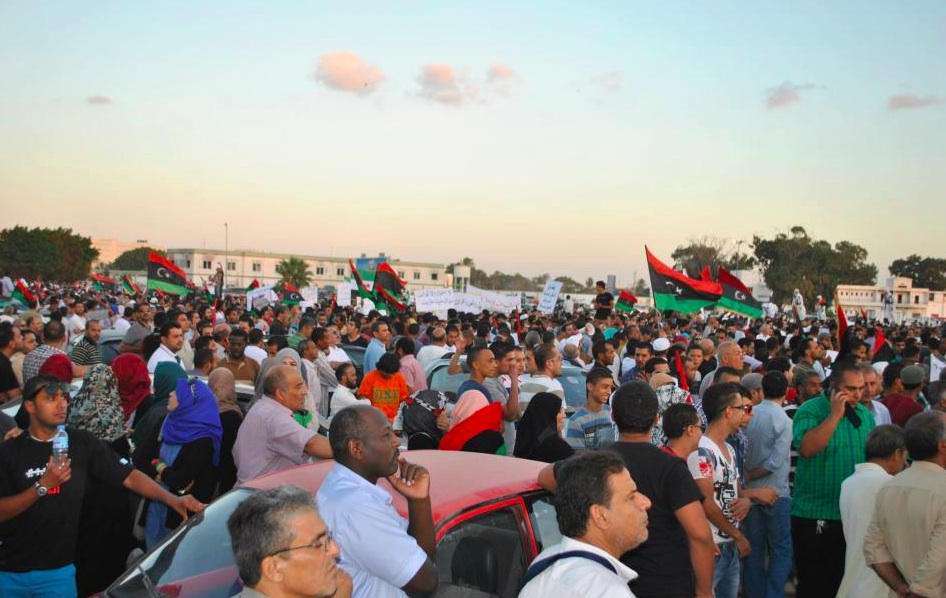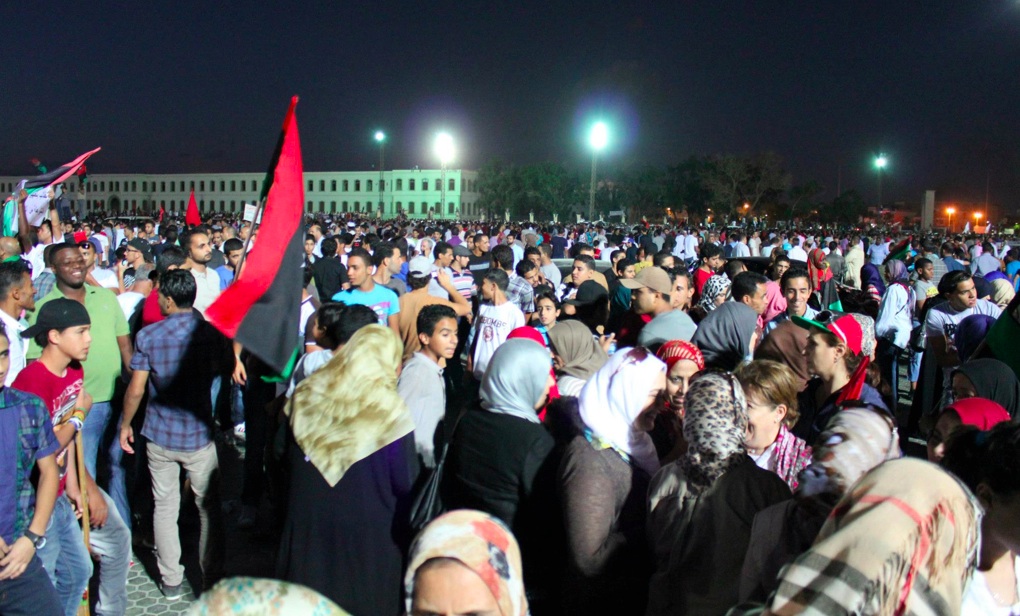[The following is part two of a two-part piece. Part one was posted Tuesday, 25 September.]
Peaceful crowds are mushrooming in Benghazi and in other cities as a direct challenge to Libyan government’s weak politics. The small group of people that attacked the US Embassy in Benghazi has prompted large crowds of peaceful protesters to fill the streets. The attack that killed Ambassador Chris Stevens touched the heart of Benghazi, whose civil society rejects harming foreign guests and friends. Only two days following a meeting of Eastern tribe leaders held on 15 September, activists met to organize a massive peaceful protest called “Rescue Benghazi Friday” to be held on 21 September. At this protest, Libyans voiced their rejection of the violent groups that killed foreigners, as well as locals, and pressured the government to disband them.
Well-Organized, Leaderless Crowds
The demonstration was organized by a leaderless group of thirty to forty activists, with no dominant political affiliations or ties to NGOs. It was a well-organized, carefully thought-out demonstration that sought to draw the biggest and most peaceful crowds possible. It was a publicized event, as illustrated with the points expressed on their flyer below, in addition to posters and banners around Benghazi announcing the time, date, and location of the demonstration. Social media was buzzing with news of the protest. Prior to the demonstration, the group pre-organized its own security protection, with about twenty to thirty police and ambulances in the event of a violent disruption by one of the militias. As a result of this outreach, over 30,000 peaceful protesters marched from Benghazi’s Tibesti Hotel to the Al-Keesh Square, synchronized with auxiliary demonstrations held in Tripoli, Derna, Zawiya, and other parts of the country.
During the organizational meeting, the itinerary of the demonstration was also pre-determined. It was decided that the demonstration would start at the Tibesti Hotel at five in the evening, and the protesters would walk three kilometers to Al-Keesh Square, which is adjacent to a military base that was confiscated by Benghazi citizens during the revolution. Since Qaddafi’s fall, the base has become the informal headquarters of various militias, including the radical Ansar al-Sharia brigade. The protestors intended to peacefully confront these brigades and demand their evacuation.

[Image from "Rescue Benghazi Friday" demonstration on 21 September. Image by Mohamed Almugherbi and Mohamed Alzawwam]
The Demands
The movement’s central demand is for the government to immediately collect weapons and to dissolve the armed security brigades that operate outside of official mandates. Protestors gave the government an ultimatum: if by Monday, 24 September, the GNC has not initiated a response to these demands, Benghazi’s population will go on strike, shutting down the city’s few institutions that do exist.
During and preceding the demonstration, a flyer was also circulated to underline the goals of the protests:
1) That the government issue a law criminalizing weapons
2) That the government withdraw all authority given to militias
3) The eviction of militias (kataib) from all government buildings and institutions
4) That Benghazi come under the rule of Libyan army and police with government support.
Peaceful Intent of Protests
All measures were taken to avoid conflict and violence. To this end, on 20 September, the group met and spoke to Ansar al-Sharia, the militia suspected of carrying out the attack on the US Consulate. They told Ansar-al Sharia that they should disarm and join the national army. The discussion also clarified that Ansar al-Sharia has the right to demonstrate and voice their views, but that they should not organize a counter-protest at the same time and place, in order to avoid conflict. Protesters emphasized the desire to establish a society inclusive of all Libyans. They announced their aim to avoid violence or hate-speech against militias and prevented participants from provoking or insulting members of the Ansar al-Sharia or any other brigade. During the demonstration, one protester attempted to confront the few members of Ansar al-Sharia who came to the demonstration. He said to them: “We hate you, go away!,” however, the group of protesters prevented him from pursuing the Ansar al-Sharia members any further.
One demonstrator echoed this goal of non-violence when she emphasized: “We went out against all kataib, not against a katiba in particular. We want all kataib to go under the National Libyan army. So, they listened, and were not there and did not disturb the demonstration.” As a symbol of the peaceful intentions of the crowds, and in celebration of World Peace Day, the protesters wore white t-shirts and white headscarves.

[Image from "Rescue Benghazi Friday" demonstration on 21 September. Image by Amel Besekri]
The Struggle for National Unity
This protest reflects the seed of a new, peaceful social movement emerging in Benghazi. It is likely to spread as it is now working with the tribal leaders and continuing to pressure the government. There is a conviction among many that what happens in Benghazi happens in all of Libya. The outpouring of solidarity embodied this expression across Libya on the day of protest. One protester said, “If Benghazi is safe, all Libya is safe. If Benghazi is violent, all Libya has a problem. Benghazi is the face of Libya.”
There is a small number who voiced their support for the brigades, positing, “You want to rescue Benghazi from whom? These are the people who saved Benghazi from Qaddafi.” Some citizens also voiced their support of Ansar al-Sharia in particular, arguing that “they are real Muslims” and they “want to protect us.”
Unfortunately, there was violence. Late on 21 September, after women and children had returned to their homes, many men stayed and attacked the military base where the kataib are based. Ansar al-Sharia had evacuated the area in anticipation of the demonstration. The men proceeded to the Al Jala’ hospital, previously under the control of the Ansar al-Sharia brigade. The men effectively succeeded at pushing them out and gaining control of the hospital. They then continued on and went to the Hawari militia (katiba of Rafallah Ashati) and asked them to empty the place, but they shot at them, killing four unarmed civilians and wounding scores, according to a witness and numerous media reports.
The Government’s Response to Peaceful Crowds of Benghazi
Some members of the government attended the demonstration. GNC members Ibrahim Sahed, Salih Jaouda, and Suleiman Zoubi marched with the crowd and expressed their support. Ibrahim Sahed spoke to the female protestors directly: “Thank you for protesting. See how you, women, are allowed to be out on the streets with the men. You are free, thank you for going on to the streets, thank you…” The protesters responded to this support by reiterating their demands. In the words of one protester, “Don’t just sit on your seats and do nothing.”
In response to the shooting late on 21 September, four members of the government made a statement on Libyan television. The statement was issued on the same day by President Mohamed Al Mgarief, the ministers of interior and defense, and the spokesman of the local council of Benghazi. They stated their support for the crowd’s confrontation with the Ansar al-Sharia militia. However, they defended Rafallah Ashati’s militia, which allegedly shot and killed the unarmed protesters. The officials declared the legality of this militia and stated that it is under government control.
The problem is twofold. First, the population had never heard of the government’s legalization of this militia. Secondly, if indeed the militia is under government control, this means the government must answer to the crimes committed by this brigade. For months it has engaged in arbitrary arrests, disappearances, kidnapping, and killings of supposed Gaddafi loyalists. They have kidnapped people and until now these people have not been found. As a result, in the eyes of the protesters, the government made two mistakes: firstly, to not announce sooner that it was in control of this militia, and the second, to basically claim responsibility for the crimes carried out by them.

[Image from "Rescue Benghazi Friday" demonstration on 21 September. Image by Amel Besekri]
Results of Crowd Action
The pressure applied by this peaceful crowd quickly yielded results. On 22 September, the Libyan army responded to their demands by occupying the kataib’s barracks and prohibiting the return of any militias.
On the evening of 22 September, the Libyan President Mohamed Al Magarief and Prime Minister Mustafa Abushagur held a press conference at the Benghazi airport and were asked if they gave orders to shoot at protesters. They responded that they do not know the identity of the shooters nor which brigade they belong to.
Political activists told Libyan media sources that this is a golden opportunity for the Libyan government to end the instability caused by militias in Benghazi and to collect weapons. The government has answered the demands of the protesters to a large extent. In the press conference of 22 September, the president vowed to implement the demands of the protests. He promised to: 1) establish military, government check points inside Benghazi, 2) give orders to the military to take control of all militias, preparing them for a merger with the national army, 3) disband all militias that are not under government control, and, finally, issue a call for self-control and non-violence. In short, the social pressure has had a swift and positive impact.
The significance of these protests for Libyan society cannot be understated. After the attacks on the US Embassy, Libyan society has responded and clearly demanded that the government act on their behalf to secure the city. This is a sign that civil society is awake, has peaceful intentions, and demands control over extremist groups. These crowds of protesters, and the protests immediately following the US Ambassador’s death, cannot be called “pro-American” protests by any means. They are pro-Libyan protests. The values that are being put forward, in harmony with the statement issued by the Eastern region tribal chiefs, are coherent with the values of any democratic society. These social groups are banding together calling for non-violence, inclusivity, tolerance, and good governance. These values echo a statement issued on 21 September by US Secretary of State Hillary Clinton on the occasion of the Tunisian Foreign Minister’s visit to Washington. Clinton summarized “the shared principles of all democracies – a commitment to nonviolence, to tolerance, and inclusivity for all people, and to upholding the rule of law.” The rising protest movement in Benghazi that is now working in cooperation with the tribal elders of the Eastern region of Libya is calling for their government to uphold exactly these principles. Their written and spoken statements, in addition to their actions, echo this desire for a peaceful, tolerant, and law-abiding society.